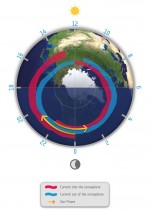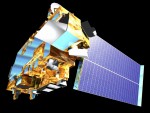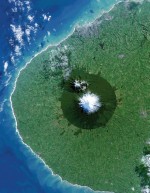
Monday, April 3rd, 2017
The CanX-7 nanosatellite built by Space Flight Laboratory (SFL) at the University of Toronto Institute for Aerospace Studies validated real-time detection and tracking of aircraft by a satellite in low-Earth orbit. The next mission phase will begin in early May 2017 with deployment of drag sails developed by SFL to accelerate the deorbiting of small

Tuesday, March 28th, 2017
Information from the European Space Agency (ESA) magnetic field Swarm mission led to the discovery of supersonic plasma jets high up in Earth’s atmosphere that can push temperatures up to almost 10,000 degrees Celsius. Presenting these findings at the Swarm Science Meeting in Canada, scientists from the University of Calgary explained how they used measurements

Tuesday, March 21st, 2017
Just a little more than two weeks after its Feb. 19, 2017, launch on a SpaceX Falcon 9/Dragon spacecraft, the Stratospheric Aerosol and Gas Experiment III (SAGE III) is now safely installed on the outside of the International Space Station, where it will monitor ozone and aerosols in Earth’s upper atmosphere. In a highly choreographed
Tuesday, March 14th, 2017
Detecting and predicting lightning just got a lot easier. The first images from a new instrument onboard NOAA’s GOES-16 satellite are giving NOAA National Weather Service forecasters richer information about lightning that will help them alert the public to dangerous weather. The first lightning detector in a geostationary orbit, the Geostationary Lightning Mapper (GLM), is

Tuesday, February 21st, 2017
The emerald golfing greens have seen better days. According to the U.S. National Golf Foundation, the number of players has steadily declined from over 30 million in 2005 (pre-recession) to 24.7 million today; 680 US and 158 Canadian courses have closed. “Golf course owners are working smarter to manage resources like water and labor more
Wednesday, February 1st, 2017
More accurate, immediate and economical information on severe weather phenomena such as hurricanes soon could be available thanks to the Weather Hazard Alert and Awareness Technology Radiation Radiosonde (WHAATRR) Glider. According to project manager Scott Wiley, the vehicle could potentially save the National Weather Service up to $15 million a year compared to current methods.

Tuesday, January 24th, 2017
Hydrologists at the Colorado Basin River Forecast Center are providing streamflow forecasts for watersheds within the Colorado River Basin, which includes some of the most parched land in the United States. “The forecasts we get from the center provide crucial information for managing our water resources and reservoir facilities,” said Dave Kanzer, a deputy chief
Monday, January 23rd, 2017
Extreme weather is listed as the No.1 global risk this year by the World Economic Forum. In addition, the draft recommendations from the Task Force on Climate-related Financial Disclosures call for a transparent and consistent process for identification of climate risks and climate action. DNV GL today releases a timely research paper exploring the role

Tuesday, January 10th, 2017
As part of the UK Space Agency’s recently launched International Partnership Programme (IPP) and its related Forests 2020 project, the agency awarded a contract worth more than £14 million to sustainability software and data company Ecometrica. The Forests 2020 project is expected to help countries improve management and protection across 300 million hectares of